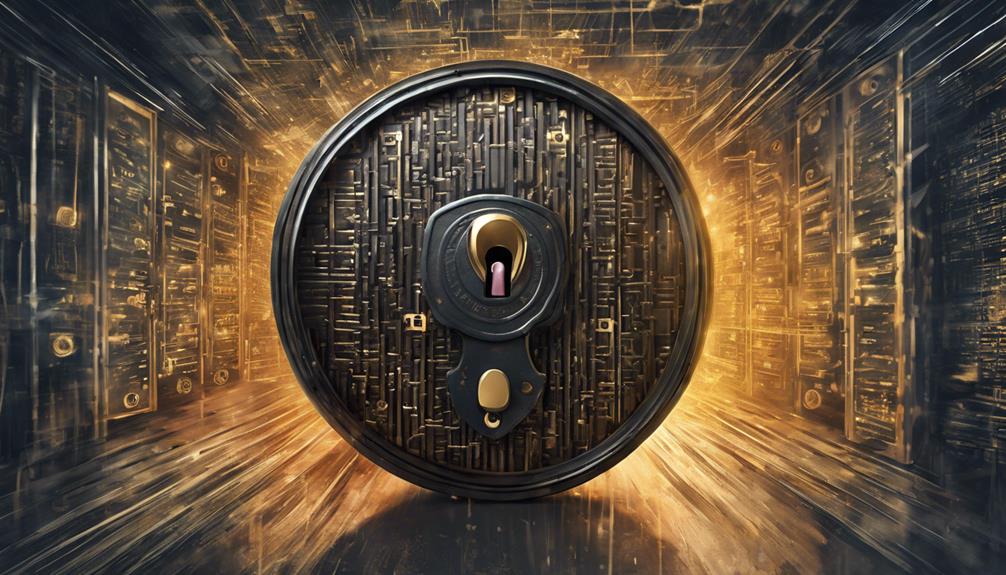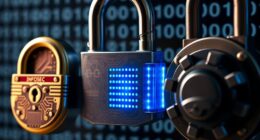AnyDesk is safe from hackers due to its meticulous security features, including strong encryption standards like RSA 2048, TLS 1.2 Protocol, and 256-bit AES Encryption. These protective measures shield against unauthorized access and data breaches, bolstering overall security. Following security best practices, such as strict verification protocols and regular software updates, further fortify AnyDesk's defenses. By downloading only from the official website, verifying access requests, and monitoring device access logs, users can enhance their cybersecurity resilience. AnyDesk's reliable platform for remote access offers a secure environment that prioritizes user data protection and confidentiality.
Key Takeaways
- AnyDesk utilizes robust security measures against hackers.
- RSA 2048 encryption and AES 256-bit encryption ensure data protection.
- TLS 1.2 Protocol enhances encryption to prevent hacking attempts.
- Strict verification protocols prevent unauthorized access.
- Regular software updates strengthen security and protect against hackers.
AnyDesk Security Features
AnyDesk's security features are meticulously designed to safeguard user data and sessions from unauthorized access. With robust encryption standards such as RSA 2048, TLS 1.2 Protocol, and 256-bit AES Encryption, AnyDesk guarantees a secure environment for remote access and data transfer. These encryption technologies not only protect user information but also prevent interception and data breaches, making AnyDesk a reliable tool for remote connections.
By implementing advanced security measures, AnyDesk prioritizes the confidentiality and integrity of user data during remote sessions. The combination of encryption and secure protocols enhances the overall security posture of AnyDesk, instilling trust in users who rely on the platform for their remote access needs.
In a digital landscape where data security is paramount, AnyDesk's commitment to providing a safe and secure environment for remote access sets it apart as a trusted solution for individuals and businesses alike.
Encryption Strengths of AnyDesk

AnyDesk boasts robust encryption features, incorporating RSA 2048 encryption, TLS 1.2 Protocol, and 256-bit AES Encryption to fortify data protection during remote sessions.
These sophisticated security measures serve as a shield against potential threats, ensuring that user information remains confidential and secure.
The encryption strengths of AnyDesk play a pivotal role in establishing its credibility as a trustworthy platform for remote access.
Encryption Features of AnyDesk
By employing robust encryption mechanisms, AnyDesk guarantees the utmost security and protection for remote connections. The software utilizes RSA 2048 encryption to establish secure remote connections, ensuring that data transmitted between devices remains confidential and inaccessible to unauthorized parties.
Additionally, AnyDesk implements 256-bit AES Encryption during remote sessions, enhancing the protection of sensitive information exchanged during the remote access process. The integration of TLS 1.2 Protocol further strengthens data encryption, making it challenging for hackers to intercept or manipulate data traffic.
These advanced encryption features not only safeguard the integrity of remote connections but also fortify the overall security posture of AnyDesk, making it a reliable and secure solution for remote access needs. With these encryption measures in place, users can trust that their data is well-protected and secure from potential cyber threats.
Security Measures Implemented
With its robust encryption measures, AnyDesk guarantees a high level of security and data protection for remote connections, making it a reliable solution for users concerned about safeguarding their information from potential cyber threats.
AnyDesk employs RSA 2048 encryption, TLS 1.2 Protocol, and 256-bit AES Encryption to provide a secure communication channel. These encryption methods not only offer strong data protection but also maintain confidentiality during remote sessions, making it challenging for cybercriminals to intercept or manipulate data.
AnyDesk's security measures are specifically designed to protect user information and prevent unauthorized access, enhancing the overall defense against potential hacking attempts. Users can trust in AnyDesk's robust encryption features to minimize the risk of security breaches and ensure safe remote desktop interactions.
Preventing Unauthorized Access

To enhance security measures and mitigate the risk of unauthorized access, users should implement strict verification protocols for individuals seeking remote access to their devices. This practice helps safeguard sensitive data and maintains the integrity of the systems.
In addition to verification processes, users can take the following precautions:
- Avoid sharing login credentials: Refrain from disclosing AnyDesk login information to unknown parties to prevent unauthorized access.
- Download from the official website: Obtain the remote access software solely from the official AnyDesk website to avoid potential risks associated with third-party sources.
- Verify the identity of remote users: Prioritize verifying the identity of individuals requesting access to deter unauthorized entry.
- Create a whitelist of authorized users: By establishing a list of approved users, the security of the system can be enhanced, reducing the likelihood of unauthorized access.
Cautionary Measures for Users

To guarantee secure remote connections while using AnyDesk, users must adhere to essential security best practices and privacy protection tips.
It is vital to verify the identity of individuals requesting access to prevent unauthorized usage and potential security breaches.
Implementing user authentication measures and maintaining a whitelist of authorized users can greatly enhance security and safeguard against malicious activities during remote sessions.
Security Best Practices
Users can implement security best practices to enhance protection when using AnyDesk for remote access. By following these measures, users can greatly reduce the risk of falling victim to scams and unauthorized access:
- Utilize Strong Encryption: AnyDesk employs robust encryption protocols such as RSA 2048, TLS 1.2, and 256-bit AES Encryption to secure remote access and protect data during transmission.
- Create a Whitelist of Authorized Users: Enhance security by maintaining a whitelist of approved individuals who are permitted to access your device via AnyDesk.
- Avoid Scams: To steer clear of scams, refrain from sharing passwords, only download AnyDesk from the official website, and verify the identity of individuals requesting access.
- Take Precautions: Implement simple precautions like not allowing unknown access requests and refraining from clicking on suspicious links to prevent falling prey to AnyDesk scammers.
Privacy Protection Tips
Enhancing privacy protection while utilizing AnyDesk for remote access involves implementing cautious measures to safeguard sensitive information and prevent unauthorized intrusion. Users can take several steps to enhance their privacy protection when using AnyDesk. The table below outlines key privacy protection tips, including using official sources for downloads, verifying identities, and running malware scans regularly.
| Privacy Protection Tips | Description |
|---|---|
| Official Sources | Download AnyDesk only from trusted and official sources to reduce the risk of malware installation. |
| Identity Verification | Verify the identity of individuals requesting remote access to prevent unauthorized users from gaining control. |
| Malware Scans | Regularly run malware scans on your devices to detect and remove any malicious software that could compromise your privacy. |
| Encryption | AnyDesk employs strong encryption protocols like RSA 2048, TLS 1.2, and 256-bit AES Encryption to secure remote connections. |
| Password Updates | Regularly update your passwords to prevent unauthorized access to your AnyDesk account and sensitive information. |
User Authentication Importance
Implementing robust user authentication measures is critical in fortifying defenses against unauthorized access when utilizing AnyDesk for remote connections. To enhance security and protect against potential breaches, users should consider the following cautionary measures:
- Utilize strong password protection: Create complex passwords that include a combination of letters, numbers, and special characters to make it harder for hackers to crack.
- Enable multi-factor authentication: Adding an extra layer of security through multi-factor authentication can greatly reduce the risk of unauthorized access.
- Regularly review device access logs: Monitoring device access logs can help detect any suspicious activities or unauthorized logins promptly.
- Adhere to security best practices and perform software updates: Following security best practices and keeping software updated with the latest patches and fixes is essential in preventing vulnerabilities that hackers could exploit.
Official Site Download Guidelines

For maximum security and reliability when downloading AnyDesk, it is vital to adhere strictly to the official site download guidelines. By obtaining AnyDesk from legitimate sources, you not only guarantee a secure download but also protect yourself from potential risks posed by compromised software. The official AnyDesk website provides a safe and authentic platform for users to access the latest versions of the software without the threat of hacking or malware.
To emphasize the importance of downloading from the official site, here are some key guidelines to follow:
| Guideline | Description | Importance |
|---|---|---|
| Official Site | Only download AnyDesk from the official website to guarantee authenticity and security. | High |
| Secure Connection | Ensure the connection to the official site is secure (https://) to prevent data interception by hackers. | Medium |
| Verify Certificate | Check for a valid SSL certificate on the website to confirm its legitimacy before downloading AnyDesk. | High |
| Update Notifications | Enable notifications for software updates to stay informed about the latest security enhancements. | Medium |
Verifying Access Requests

When considering access requests, verifying the identity of individuals is essential to prevent unauthorized access to your device. This precaution is critical in safeguarding against AnyDesk scams and potential hacking attempts. Here are some key points to keep in mind:
- Verify the identity of the individual requesting remote access before granting permission.
- Be cautious of individuals claiming to be tech support agents, especially if the request is unsolicited.
- Refrain from sharing access codes or passwords with unknown parties to mitigate the risk of unauthorized access.
- Official companies typically do not request immediate remote access for technical issues, so exercise caution if such requests arise unexpectedly.
Reducing Hacker Risks With Anydesk

Enhancing cybersecurity measures with AnyDesk is paramount in reducing hacker risks and ensuring secure remote connections. AnyDesk implements robust security features such as RSA 2048 encryption, TLS 1.2 Protocol, and 256-bit AES Encryption, which greatly decrease the threat of unauthorized access by cybercriminals.
By employing these advanced encryption methods, AnyDesk effectively safeguards user data and prevents hackers from intercepting sensitive information transmitted during remote sessions. The utilization of secure encryption not only minimizes the vulnerability to hacking attempts but also enhances overall security, protecting users' devices from potential hacker threats.
AnyDesk's commitment to maintaining a high level of security through encryption and secure protocols addresses the prevalent problem of cybersecurity breaches, providing users with a reliable and safe platform for remote access without compromising on data protection.
Exercising Caution With Passwords

With the implementation of robust encryption technologies like RSA 2048 encryption and TLS 1.2 Protocol, AnyDesk underscores the importance of exercising caution with passwords to further fortify remote connection security.
When using AnyDesk, it is essential to be vigilant in managing passwords and sensitive information to mitigate potential hacking attempts effectively.
Here are some key points to keep in mind:
- Avoid Sharing Passwords: Refrain from sharing passwords with anyone, including individuals claiming to be from technical support.
- Protect Personal Information: Be cautious about sharing personal information while using AnyDesk to prevent unauthorized access to sensitive data.
- Secure Login Credentials: Safeguard your login credentials and never disclose them to unknown parties to maintain the security of your accounts.
- Update Passwords Regularly: Routinely update your passwords with strong, unique combinations to enhance security measures and lower the risk of unauthorized access to your devices and data.
Remaining Vigilant With Anydesk

How can users ensure their security while using AnyDesk and remain vigilant against potential threats?
When utilizing AnyDesk, it is important to watch out for warning signs of scams and avoid remote access requests from unknown sources. Scammers often exploit AnyDesk to gain unauthorized access, steal sensitive information, and plant malware on devices. To stay safe, users should be cautious of unexpected AnyDesk installation requests and verify the legitimacy of such requests through official channels. Additionally, reporting any suspicious activity promptly is essential in preventing potential security breaches.
In light of these risks, considering a secure alternative like HelpWire, which offers advanced encryption and strong authentication, can provide a safer remote support option. The rise in unauthorized access to platforms like PayPal through deceptive AnyDesk installations highlights the importance of remaining vigilant and proactive in safeguarding personal information.
Frequently Asked Questions
What Are the Risks With Anydesk?
Understanding the risks with AnyDesk is imperative. Scammers exploit it for remote access scams, leading to financial losses and privacy breaches. With over $800 million lost to tech support scams, caution when using AnyDesk is essential.
Can Anydesk Be Used by Hackers?
AnyDesk, a remote access tool, can be exploited by hackers to gain unauthorized control over victims' devices. Understanding the risks associated with AnyDesk is essential to protect against cyber threats and prevent potential data breaches.
Can Anyone Access My Computer From Anydesk?
Anyone accessing your computer through AnyDesk must have your explicit permission and a unique session code. User-controlled access permissions prevent unauthorized entry, ensuring security against unsanctioned remote access. AnyDesk's encryption further safeguards against unauthorized access.
What Happens if I Delete Anydesk?
Deleting AnyDesk removes the application from your device, terminating all active sessions and connections. Reinstallation is possible from the official website or app store without compromising your device's security. Regularly updating and securing login credentials is advisable.
Conclusion
To sum up, while AnyDesk offers robust security features to protect users from hackers, it is essential for individuals to remain vigilant and take precautionary measures to prevent unauthorized access.
By following guidelines provided by the official site, verifying access requests, and exercising caution with passwords, users can reduce the risk of falling victim to cyber attacks.
Remember, in the digital sphere, it is always better to be safe than sorry.









